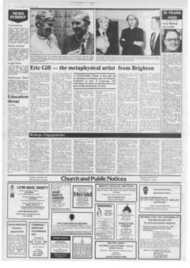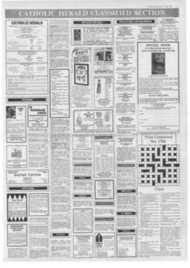Page 10, 1st October 1982
Page 10

Report an error
Noticed an error on this page?If you've noticed an error in this article please click here to report it.
Tags
Share
Related articles
Dr Cecil Northcott Writing In The Daily Telegraph Of April
Those Priestly Freemen Of England
' Priestly
The Law And Fr Hastings
Letters To The Editor The Arab-israel Conflict
`Oh what simple but sustaining fare' Charterhousef wbe Chronicle
MEMORY WAS stirred for me by a letter in The Daily Telegraph recently from a retired priest, Fr Robert Goold, who asked: "Why the fuss about free school meals?"
He recalled that at the Jesuit grammar school he attended in North London the boys could buy a book of tickets on Monday morning for 10d which was, presumably, less than 5p of our present debased coinage — enabling them to have home-made soup at midday with the sandwiches they had brought with them.
He says: "It was a happy social occasion for the boys . . . one of the joyous facts of life and we paid for it at a very cheap rate. We thrived on it, not least Alfred Hitchcock whose father was a greengrocer in Leytonstone."
Fr Goold was at St Ignatius College, Stamford Hill, between 1913 and 1919; and by the time I followed him there the soup was no longer served.
However, we had a tuckshop, in which, as well as the popular brands of manufactured sweets, you could buy, very cheaply, superbly meaty shepherd's pie, potatoes baked in their jackets, doughnuts of a quality that I have never since experienced, and, in the summer, ice-cream that was infinitely superior to the kinds now normally available.
All these goodies were prepared by a large and kindly man, Brother Butwillow, whose name, revered in my memory, I hope I have spelled correctly.
Enquiries among the inhabitants of lesser schools, whom we regularly encountered in order to beat them at football and cricket, confirmed my belief that our effortless superiority also extended to the matter of tuck-shops.
The soup, in my day, lingered as a memory in the mysterious name given to what was, in effect, the school hall. It was called the Soup Room, and I did have a sufficiently enquiring mind to find out the reason for this.
But Fr Goold has made me aware that I should have pushed my researches further into the room's earlier and even more important history. He tells me, in a letter, that the room was the original church of St Ignatius before the present large and impressive church was built in 1903.
He says: "Some of those boys having soup with me, in 1913, had been baptised in that same room."
Earlier still, as he explains, it had been the old coach house of a place called Morecombe Lodge, which the Jesuits bought in 1894 to be their new school, St Ignatius College, with 40 boys on the register.
Travellers by train from London to the (relatively) new St Ignatius College — with about 1,000 boys, in modern buildings, at Enfield — can still see the two tall towers of the church by the site of the old college, because they are visible from the railway and, indeed, for many miles around.
I have long felt that North London does not take sufficient pride in the architectural merits of this building; so I was glad to find that one rather quirky pundit, Ian Nairn, praises it. In Nairn's London he credits it, especially its towers, with "grandeur", and says: "this building means business; and the extra force hits you straight away."
Mindful of other things than the tuck-shop, I sometimes felt similarly about some aspects of the College.
King Charles's Heads
I AM grateful to Fr Goold for enabling me once more to write about St Ignatius, Stamford Hill, in this column; for this is my own last contribution to the long Charterhouse "line" started originally by the editor, then and now, Gerard Noel who will once more be taking up the running next week and later handed over by him to Patrick O'Donovan for what turned out to be a 'lengthy and glorious innings.
Bernard Levin, in the Times, with his frequent mention of two not wholly unconnected subjects, the Gas Board and Wagner, set a precedent enabling columnists to have what Dickensians, mindful of the obsessive Mr Dick, in David Copperfield, used to call a "King Charles's Head".
St Ignatius, Stamford Hill, has been one of my King Charles's Heads. The other—as I sincerely hope has been noticed — has been London's only preReformation Catholic church, St Etheldreda's, in Ely Place, Holborn; and I am delighted that I can quite legitimately bring it into my valedictory Charterhouse.
Scarcely pausing to mention once again that St Etheldreda's still requires contributions to its fund for urgent building work, I hasten to announce that this ancient and splendid church is once again making history.
The Parish Priest of St Etheldreda's, Fr Christopher Cunningham, tells me that the Anglican Bishop of Ely, the Rt Rev Peter Walker, has accepted an invitation to be present at Solemn Vespers at St Etheldreda's and afterwards preach.
Before the Reformation, of course, this famous church was the chapel of the London residence of the Bishops of Ely.
The last pre-Reformation Bishop of Ely was Thomas Thirlby, who, after being made the first and only Bishop of Henry the eighth's short-lived Diocese of Westminster, made his peace with the Church under Queen Mary, and was one of the "Eleven Bishops" who died as confessors of the faith in captivity under Elizabeth.
As Fr Cunningham says, the coming of Bishop Peter Walker to preach in a place with such associations is "an historic ecumenical occasion".
The visit was scheduled for Wednesday, September 29, the day this issue of the Catholic Herald went to press, and it will have taken place by the time my note of it is read.
The fate of those priests
SEVERAL readers have written to me with answers to my questions about the group of Jesuits who were trained in Namur before the Second World War with a view to entering Stalin's Russia; and I have to thank Mrs Clare Hourihane, of Bournemouth; Mr John J. Walsh, of Prestatyn; Winifride Laughlin, of Wavertree, Liverpool; and Sister Joseph Lynch, of La Sainte Union Convent, in North-West London.
Between them they gave me a great deal of information. I apologise to any of them whose signature I may have misread. I am particularly indebted to the holy nun, who took the trouble to write a long letter, in spite of being aged 93. She says there is no mystery about the fate of the priests. But for me, alas, at present, there still is; for not all my informants entirely agree with each other.
For instance, although one of them says that in the end the Vatican stopped the priests from attempting to enter Russia, others at least imply that some of them did do so.
Two of them appear to have got as near as Estonia, but this seems to have been before that Catholic country was swallowed up by the Soviet Union.
On balance, it seems that none of the priests ever did get into the Soviet Union itself, although some worked with Russian communities outside it, in Shanghai, for example.
However, my kind
correspondents have, between them, given me quite a few leads and names to write to, and I hope to get, and give you, the full story one of these days.
Au revoir
I NOTED with great pleasure that Gerald Priestland's successor as the BBC's Religious Affairs Correspondent is to be Rosemary Harthill, who was for a long time his assistant.
I know that a great many Herald readers have come to admire her highly professional reporting, her lack of bias, and her pleasant broadcasting voice, and they, too, will welcome her appointment.
My taking note of it here, presents me with an opportunity to thank the large number of Charterhouse readers who wrote to me • about the series of broadcasts I did in the Yours Faithfully programme after Gerald Priestland retired; and the advent of the new-style Charterhouse, to which I wish the greatest possible success, provides the obvious occasion for thanking those who wrote to me about this column.
I am sure that all these kind correspondents — as well as some who were less kind — will understand that it was quite impossible to reply to everything individually.
I look forward to remaining with you regularly — on other pages. Au Revoir.
blog comments powered by Disqus











